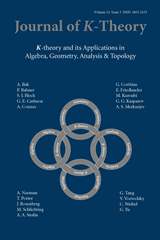Article contents
Homotopy classification and the generalized Swan homomorphism
Published online by Cambridge University Press: 07 January 2009
Abstract
In his fundamental paper on group cohomology [20] R.G. Swan defined a homomorphism  for any finite group G which, in this restricted context, has since been used extensively both in the classification of projective modules and the algebraic homotopy theory of finite complexes ([3], [18], [21]). We extend the definition so that, for suitable modules J over reasonably general rings Λ, it takes the form
for any finite group G which, in this restricted context, has since been used extensively both in the classification of projective modules and the algebraic homotopy theory of finite complexes ([3], [18], [21]). We extend the definition so that, for suitable modules J over reasonably general rings Λ, it takes the form  here
here  is the quotient of the category of Λ-homomorphisms obtained by setting ‘projective = 0’. We then employ it to give an exact classification of homotopy classes of extensions 0 → J → Fn → … → F0 → F0 → M → 0 where each Fr is finitely generated free.
is the quotient of the category of Λ-homomorphisms obtained by setting ‘projective = 0’. We then employ it to give an exact classification of homotopy classes of extensions 0 → J → Fn → … → F0 → F0 → M → 0 where each Fr is finitely generated free.
- Type
- Research Article
- Information
- Copyright
- Copyright © ISOPP 2009
References
- 1
- Cited by




